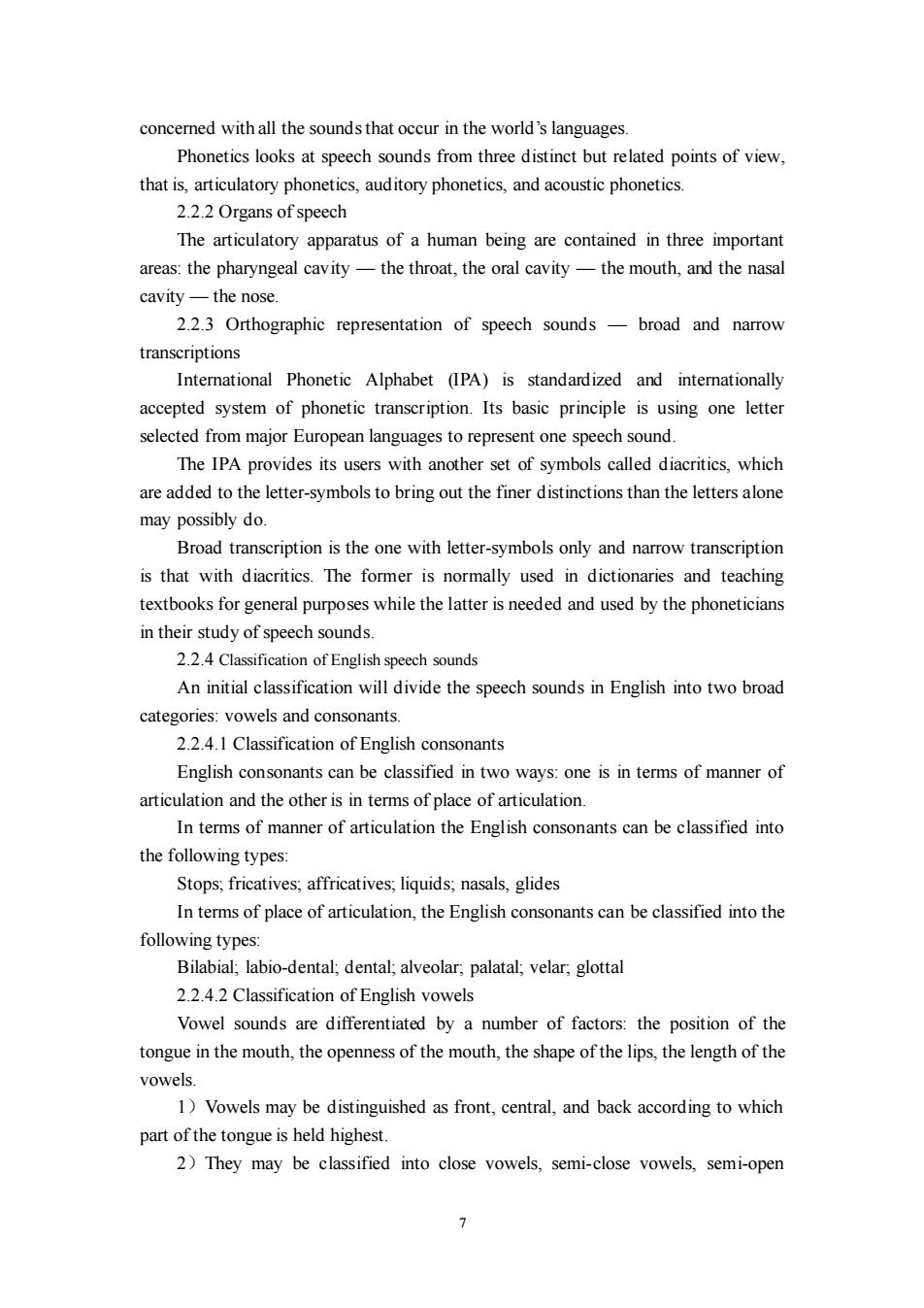正在加载图片...

concemed with all the sounds that occur in the world's languages. Phonetics looks at speech sounds from three distinct but related points of view, that is,articulatory phonetics,auditory phonetics,and acoustic phonetics 2.2.2 Organs of speech The articulatory apparatus of a human being are contained in three important areas:the pharyngeal cavity-the throat,the oral cavity-the mouth,and the nasal cavity-the nose 2.2.3 Orthographic representation of speech sounds-broad and narrow transcriptions International Phonetic Alphabet (PA)is standardized and internationally accepted system of phonetic transcription.Its basic principle is using one letter selected from major European languages to represent one speech sound. The IPA provides its users with another set of symbols called diacritics.which are added to the letter-symbols to bring out the finer distinctions than the letters alone may possibly do. Broad transcription is the one with letter-symbols only and narrow transcription is that with diacritics.The former is normally used in dictionaries and teaching textbooks for general purposes while the latter is needed and used by the phoneticians in their study of speech sounds 2.2 Classification of English speech sounds An initial classification will divide the speech sounds in English into two broad categories:vowels and consonants 2.2.4.1 Classification of English consonants English consonants can be classified in two ways:one is in terms of manner of articulation and the other is in terms of place of articulation. In terms of manner of articulation the English consonants can be classified into the following types: Stops,fricatives,affricatives,liquids,nasals,glides In terms of place of articulation,the English consonants can be classified into the following types: Bilabial;labio-dental,dental,alveolar,palatal;velar,glottal 2.2.4.2 Classification of English vowels Vowel sounds are differentiated by a number of factors:the position of the tongue in the mouth,the openness of the mouth,the shape of the lips,the length of the vowels. 1)Vowels may be distinguished as front,central,and back according to which part of the tongue is held highest. 2)They may be classified into close vowels,semi-close vowels,semi-open7 concerned with all the sounds that occur in the world’s languages. Phonetics looks at speech sounds from three distinct but related points of view, that is, articulatory phonetics, auditory phonetics, and acoustic phonetics. 2.2.2 Organs of speech The articulatory apparatus of a human being are contained in three important areas: the pharyngeal cavity — the throat, the oral cavity — the mouth, and the nasal cavity — the nose. 2.2.3 Orthographic representation of speech sounds — broad and narrow transcriptions International Phonetic Alphabet (IPA) is standardized and internationally accepted system of phonetic transcription. Its basic principle is using one letter selected from major European languages to represent one speech sound. The IPA provides its users with another set of symbols called diacritics, which are added to the letter-symbols to bring out the finer distinctions than the letters alone may possibly do. Broad transcription is the one with letter-symbols only and narrow transcription is that with diacritics. The former is normally used in dictionaries and teaching textbooks for general purposes while the latter is needed and used by the phoneticians in their study of speech sounds. 2.2.4 Classification of English speech sounds An initial classification will divide the speech sounds in English into two broad categories: vowels and consonants. 2.2.4.1 Classification of English consonants English consonants can be classified in two ways: one is in terms of manner of articulation and the other is in terms of place of articulation. In terms of manner of articulation the English consonants can be classified into the following types: Stops; fricatives; affricatives; liquids; nasals, glides In terms of place of articulation, the English consonants can be classified into the following types: Bilabial; labio-dental; dental; alveolar; palatal; velar; glottal 2.2.4.2 Classification of English vowels Vowel sounds are differentiated by a number of factors: the position of the tongue in the mouth, the openness of the mouth, the shape of the lips, the length of the vowels. 1)Vowels may be distinguished as front, central, and back according to which part of the tongue is held highest. 2)They may be classified into close vowels, semi-close vowels, semi-open